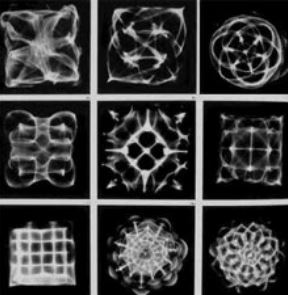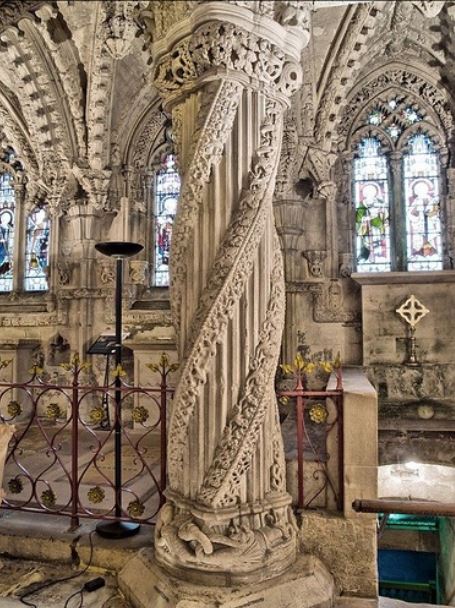
Many Ancient temples and sacred monuments were built in a true East and West alignment. You entered the from the west and faced the altar in the East. One such holy site with this alignment is the famous Rossyln Chapel in Scotland. It was founded on the autumn equinox in 1446 and was dedicated to St. Matthew.
Most of us are aware of the many esoteric conspiracies around Rosslyn Chapel’s relationship to the Knight’s Templar, the Masons, and the Holy Grail through the “Da Vinci Code” by Dan Brown. ” The site is also thought to have been originally an ancient Druid Holy site.
During my endless research into Invisible Architecture (for that future book!), I keep discovering such an amazing relationship between worship, acoustics and architecture. Rossyln Chapel is a perfected example of this – it has often been refereed to a “book carved in stone.”
The chapel stands on fourteen pillars, which form an arcade of twelve pointed arches on three sides of the nave. The three pillars at the east end of the chapel are named, from north to south: the Master Pillar, the Journeyman Pillar and, most famously, the Apprentice Pillar, showing the churches Masonic relationship. The pillars are covered with 213 intricately carved cubes, which protrude from them. A father and son team , Thomas and Stuart Mitchell realized that the designs on the cubes resembled the geometric patterns seen in Cymatics.

Cymatics, discovered by Hans Jenny, is essentially the study of how sound waves and frequencies influence matter. Jenny found patterns are formed by placing powder or sand on a flat surface and vibrating the surface at various frequencies. Different notes produce various shapes including flowers, diamonds and hexagons, called Chaldni patterns.

By matching these Chladni patterns with musical notes corresponding to the same frequencies, the father-and-son team of Thomas and Stuart Mitchell produced a tune which Stuart calls the Rosslyn Motet. “It is what we could call ‘frozen music’, a little like cryogenics. The music has been frozen in time by symbolism. It was only a matter of time before the symbolism began to ‘thaw out’ and begin to make sense to scientific and musical perception,” said T. Mitchell.
Using skills he learned as an RAF code-breaker during the Korean War and his lifetime knowledge of classical music, he finally realized they depicted the vibrations of musical notes. He said: “It was a Eureka moment to end all Eureka moments. Many angels were carrying musical instruments and some were even grouped as if they were a choir. But one angel gave me the biggest problem. He was carrying something and at first I thought it was musical instrument which had been lost in the mists of time. It was only when I realized that he was carrying a musical stave, the blueprint for all musical composition, that I knew I was looking at a secretly coded piece of music.”
Stuart Mitchell said the tunes could have been hidden because knowledge of harmonics may have been seen as dangerous, even heretical, by 15th Century church authorities. Interestingly the Devil’s Chord, diabolus in musica, makes an appearance in the music. “In the ceiling is this jump of an augmented fourth, in fact it opens up with an augmented fourth,” says Mitchell. “The Catholic Church had banned this interval (seven semitones) from medieval music as it was believed to be disturbing and therefore diabolical. Perhaps St Clair (founder of the chapel) was indeed challenging the authority of the church. The music itself, according to Mitchell is a mix of Celtic melodies and secular worship crossed with a kind of Christian worship, but not Catholic. What we have here is a recorded piece of music, it is almost like a compact disc from the 15th Century.” The Rosslyn Motet is avail on CD.
Here is a link, where you can take a virtual tour of the inside of Rosslyn Chapel with music. https://www.rodedwards.com/interactive-files/Rosslyn_Chapel/index.html



